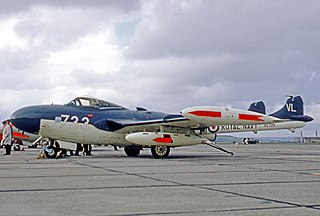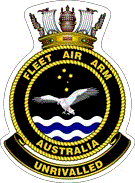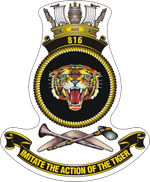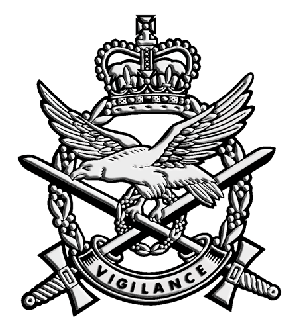
HMAS Melbourne (R21) was a Majestic-class light aircraft carrier operated by the Royal Australian Navy (RAN) from 1955 until 1982, and was the third and final conventional aircraft carrier to serve in the RAN. Melbourne was the only Commonwealth naval vessel to sink two friendly warships in peacetime collisions.

The de Havilland Sea Venom is a British postwar carrier-capable jet aircraft developed from the de Havilland Venom. It served with the Royal Navy Fleet Air Arm and with the Royal Australian Navy. The French Navy operated the Aquilon, developed from the Sea Venom FAW.20, built under licence by SNCASE (Sud-Est).

HMAS Sydney (R17/A214/P214/L134) was a Majestic-class light aircraft carrier operated by the Royal Australian Navy (RAN). She was built for the Royal Navy and was launched as HMS Terrible (93) in 1944, but was not completed before the end of World War II. The carrier was sold to Australia in 1947, completed, and commissioned into the RAN as Sydney in 1948.

The Fleet Air Arm (FAA), known formerly as the Australian Navy Aviation Group, is the division of the Royal Australian Navy (RAN) responsible for the operation of aircraft. The FAA was founded in 1947 following the purchase of two aircraft carriers from the Royal Navy. FAA personnel fought in the Korean War and the Vietnam War, and participated in later conflicts and operations from host warships.

HMAS Albatross is the main naval air station for the Royal Australian Navy's (RAN) aviation branch, the Fleet Air Arm. The base, located near Nowra, New South Wales, was formally established in May 1942 as Royal Australian Air Force (RAAF) base RAAF Nowra, then was transferred to the Royal Navy as HMS Nabbington in 1944, and operated as a naval air station until it was decommissioned in late 1945. In 1948, the airfield was commissioned into the RAN as HMAS Albatross, as the primary shore base for the Fleet Air Arm. Since 2011, five squadrons of the Fleet Air Arm operate from Albatross. The current commander of the base is Captain Robyn Phillips, RAN.

The CAC Wirraway is a training and general purpose military aircraft manufactured in Australia by the Commonwealth Aircraft Corporation (CAC) between 1939 and 1946. It was an Australian development of the North American NA-16 training aircraft. The Wirraway has been credited as being the foundation of Australian aircraft manufacturing.

No. 5 Squadron was a Royal Australian Air Force training, army co-operation and helicopter squadron. The squadron was formed in 1917 as a training unit of the Australian Flying Corps in Britain, readying pilots for service on the Western Front. It subsequently became a naval fleet co-operation squadron, but was later redesignated as No. 9 Squadron RAAF before being re-formed as an army co-operation squadron during World War II. In the mid-1960s, it was re-formed as a helicopter squadron, before being disbanded in December 1989, when it was used to form the Australian Defence Force Helicopter Training School.

851 Squadron was a Royal Australian Navy Fleet Air Arm squadron. The squadron operated over two periods between 1954 and 1984, mainly in the training and transport roles.

816 Squadron is a Royal Australian Navy Fleet Air Arm squadron that started out as a Royal Navy unit, 816 Naval Air Squadron.

Australia was a member of the international coalition which contributed military forces to the 1991 Gulf War, also known as Operation Desert Storm. More than 1,800 Australian Defence Force (ADF) personnel were deployed to the Persian Gulf from August 1990 to September 1991, while contingents from the Royal Australian Navy circulated through the region in support of the sanctions against Iraq until November 2001. In August 1990, two frigates HMAS Adelaide and HMAS Darwin and the replenishment ship HMAS Success left for the Persian Gulf. HMAS Success had no air defences, so the Army 16th Air Defence Regiment was embarked. On 3 December 1990, HMAS Brisbane and HMAS Sydney (IV) relieved HMAS Adelaide and HMAS Darwin. On 26 January 1991, HMAS Westralia replaced HMAS Success. A Navy clearance diving team was also deployed for explosive ordnance disposal and demolition tasks. Australian ships were in danger of sea mines and possible air attacks. In a number of recorded incidents, HMAS Brisbane encountered free floating mines, on one occasion narrowly avoiding a collision. Both HMA Ships Brisbane and Sydney encountered significant air threat warnings from Iran and Iraq throughout the initial period of the commencement of the Desert Storm Campaign. The detection of land based Silkworm anti-ship missiles from Iran throughout the campaign also added to the challenges for both crews as well as the multi-national Naval Forces.

817 Squadron was a Royal Australian Navy Fleet Air Arm squadron. It was originally formed as part of the Royal Navy's Fleet Air Arm for service during World War II and took part in combat operations in Norway, North Africa, Sicily and off the coast of France. Following the conclusion of hostilities, the squadron was disbanded in 1945. In 1950, it was re-raised as part of the Royal Australian Navy and subsequently took part in the Korean War. Recent deployments have included Operation Falconer, Operation Slipper and Operation Sumatra Assist. In December 2011, the squadron was disbanded.

805 Squadron was a Royal Australian Navy Fleet Air Arm squadron. Originally formed as 805 Naval Air Squadron of the Royal Navy Fleet Air Arm in 1940 and operating for the duration of World War II in both the Mediterranean and Pacific theatres. 805 Squadron was recreated as a unit of the Royal Australian Navy (RAN) in 1948, and operated from Australian aircraft carriers until 1982, having the distinction of being the last fast jet squadron in the RAN. 805 Squadron was re-established in 2001 to operate the Kaman Super Seasprite as a replacement for helicopters currently in service, but problems with the helicopters saw the project cancelled and the squadron disbanded in 2008.

The Australian Army Aviation (AAAvn) is an administrative corps of the Australian Army. It was formed on 1 July 1968. The motto of the Australian Army Aviation corps is Vigilance.

725 Squadron is a naval aviation squadron of the Royal Australian Navy (RAN) Fleet Air Arm. The squadron was originally created in August 1943 as part of the Fleet Air Arm of the Royal Navy. It initially served as a fleet requirements unit, was rerolled in August 1945 as a target towing unit, then was disbanded in December 1945. In January 1958, the squadron was re-formed, as a fleet requirements and communications unit of the RAN, operating a variety of fixed-wing aircraft. The squadron was redesignated as an anti-submarine warfare training squadron in May 1959, then was decommissioned in May 1961 and absorbed into 724 Squadron. 725 Squadron was recommissioned in November 1962 as an operational anti-submarine helicopter squadron, flying the Westland Wessex. During this commission, the squadron was involved in HMAS Sydney's troop transport voyages, the rescue of personnel following the Melbourne-Voyager collision, and the Operation Navy Help Darwin relief effort post-Cyclone Tracy. The squadron was decommissioned in December 1975. 725 Squadron was commissioned for the fourth time in June 2015, this time as a training unit for MH-60R Seahawk Romeo helicopters: the squadron had been reactivated two years prior as a non-commissioned unit train on and accept into service the Romeos.
724 Squadron was a Royal Navy Fleet Air Arm and Royal Australian Navy Fleet Air Arm flying squadron. The squadron was formed for the first time in 1945 and was last disbanded in 1984.

The Australian Fleet Air Arm Museum, formerly known as Australia's Museum of Flight, is a military aerospace museum located at the naval air station HMAS Albatross, near Nowra, New South Wales. The museum was opened in 1990, although efforts to preserve artifacts related to Australia's naval aviation history began in 1974. The museum houses aircraft used throughout the history of the Fleet Air Arm, the naval aviation branch of the Royal Australian Navy (RAN), along with other aircraft of relevance to Australia's aviation history, and memorabilia relating to Australian aircraft carriers. The museum includes 34 aircraft and helicopters in its collection. It is open to the public daily, except for major public holidays. The museum building is also home to Albatross Aero Club.

The first involvement Australia had with naval aviation was in 1911, when an Australian-born Royal Navy officer became one of the first four naval officers to receive pilot qualifications. During World War I, the Royal Australian Navy (RAN) experienced several forms of airborne operation, with HMAS Brisbane operating a seaplane, while HMA Ships Sydney and Australia were used for experiments with aircraft launch platforms. An aircraft embarked aboard Sydney was also involved in one of the first naval air battles. Several Australians also flew as part of the Royal Naval Air Service.

The McDonnell Douglas A-4G Skyhawk is a variant of the Douglas A-4 Skyhawk attack aircraft developed for the Royal Australian Navy (RAN). The model was based on the A-4F variant of the Skyhawk, and was fitted with slightly different avionics as well as the capacity to operate AIM-9 Sidewinder air-to-air missiles. The RAN received ten A-4Gs in 1967 and another ten in 1971, and operated the type from 1967 to 1984.
The Australian Defence Force Helicopter School (ADFHS) was an Australian Defence Force unit responsible for training helicopter pilots. It was formed in 1990 and disbanded in 1998.

The Royal Australian Navy operated Grumman S-2 Tracker anti-submarine warfare aircraft from 1967 to 1984. The type flew from the aircraft carrier HMAS Melbourne and shore bases. A total of 32 Trackers were purchased in two batches which were delivered in 1967 and 1977.






















